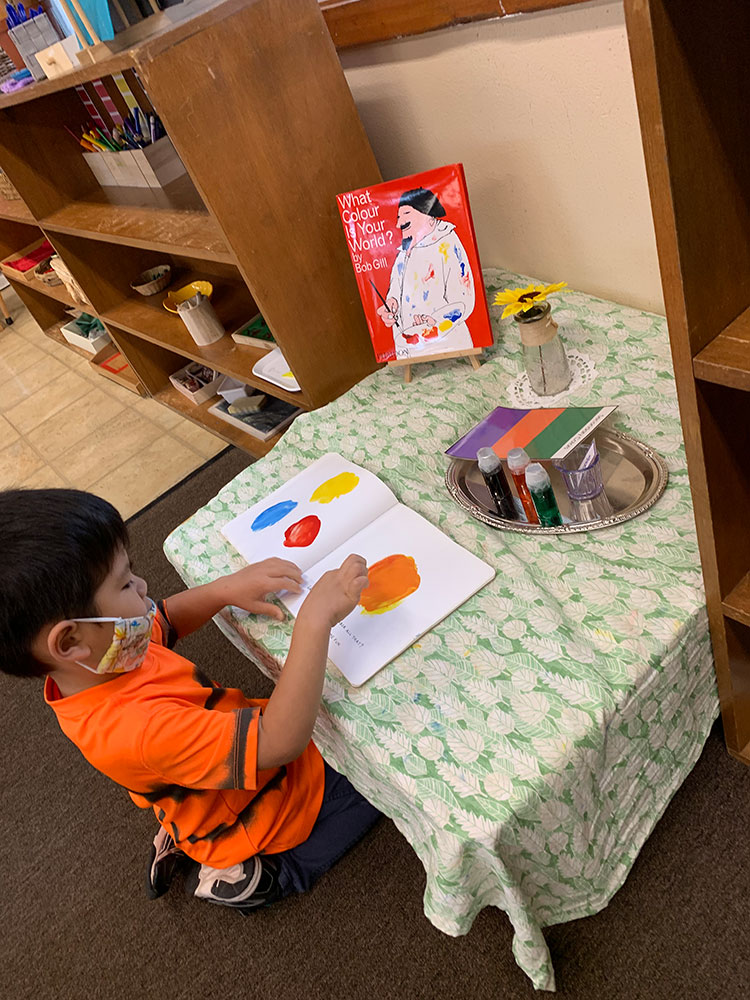
Play is the work of the Child
Dr. Maria Montessori
Dr. Montessori observed that children enjoyed play based in reality, the children were happier and engaged longer with activities that were of “real” materials.
When you walk into a Primary Montessori classroom, you might notice things missing:
The classroom, however is filled with beautiful wooden, glass, ceramic and “real” activities. In the Montessori classroom, they are called “materials”. Children “work” with the materials, rather than “play” with the toys. Many of the language cards and activates are hand-made by the guide.
Let’s explore how the Montessori classroom fosters imagination and creativity without toys.
Dr. Montessori found that grounding young children in reality helps the child sort out the difference. It may seem that in the Montessori classroom, imagination is not encouraged. However, the opposite is true. Children who are grounded in reality first, also have an active imagination.
In the Montessori classroom you will find solid, tactical, sensorial, and real objects, items found in the home. Children don’t need to play “house” because school is a “Children’s House”.
For three years, the child stays in the same classroom with the same guide. You might wonder, “don’t they get bored?” Quite the opposite actually: this is where creativity is developed. The children learn to use the materials and then use the same materials over and over again in various ways. The guide gives the initial lessons, the children then begin to discover the extensions on their own. It is fascinating to watch.
Dr. Montessori states “The true basis of the imagination is reality”. Further research shows that intelligence is developed by critical analysis of perceived reality, not through fantasy and make-believe. (The Advanced Montessori Method, pg. 196). Reality is perceived by the senses, something that is easily recognizable. Imagination is based on the senses and is firmly tied to reality. To construct oneself, the children must have real and multi-sensory experiences with real objects.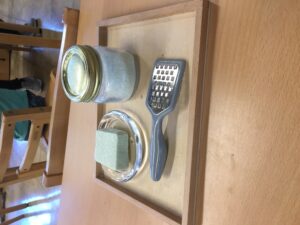
There is dramatic and imaginative play inside the Montessori classroom. An example I have from an observation, just yesterday.
The children were in the last 20 minutes of the morning work period. Notice, there is a painted line that is around the outside of the circle rug. A 3 ½ year old boy had put his work away. He stood on the line and became a “train”. I observed him moving along the line, stopping if there was someone in the way, making train sounds. He even let me know as he passed by me that he was a train. He continued this imaginative play until the end of the work period.
This type of activity is fostered in the classroom. The guides look for children to be purposeful. This child was absolutely purposeful. The guides will just ensure the child does not engage in the 3-D’s.
Children and environment are not:
If a child is not participating in one of the 3 D’s, children have the freedom to use imagination and creativity.
Continuing along this path of “The Child’s Work is Their Play” I spent the full 2.5 hours in a 3-6 classroom. I quietly observed 3 different children. I would like to share my running record of a three-year-old child who is new to the classroom environment this year. I have just changed her name.
I will call her “Tori”.
I arrived midway through the morning circle.
8:30 am – The morning circle began. The children sang songs and had their morning greeting. They went through the calendar learning the days of the week, the date, the month, and the year. They sang about the weather and even sang about a “meteorologist”.
The classroom guide gave a group lesson – “how to sit in a chair”. The older children in the group were eager to show the others and only some of the younger children were brave to try. Participating in the group takes courage and confidence, this takes time.
8:45 am – Children are dismissed to work
Tori:
8:45 am – Sitting at circle, Tori stayed on the line, it is ok to take time – this is a new environment for Tori, she is new to Montessori – we know, with consistency she will become comfortable in the classroom and develop the confidence to move about the community.
8:50 am – Tori took shoes off and adjusted socks
8:52 am – She put shoes back on
9:03 am – Followed another girl who had a work rug and an activity – deciding where to place the work rug. Tori followed her
9:04 am – The classroom guide walked by Tori, the guide gave Tori solid eye contact and a slight nod of the head, just enough to reassure Tori.
9:05 am – Tori chose a puzzle – parts of a turtle and joined her friend at the rug. The two girls worked together on the puzzle
9:07 am – The other girl decided to move her rug, she started pulling rug across the floor, the puzzle slid off the rug, Tori picked it up and returned the puzzle to the shelf.
The girl returned the rug to the rug basket and sat at the “look-at table” The look-at table has a large labyrinth with a long stick and a marble. The stick and the marble are in a glass jar, with a small doily at the bottom of the jar.
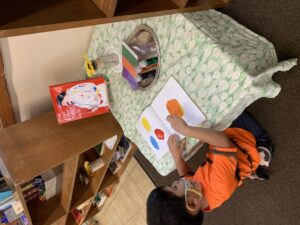 The two girls spent 10 minutes together at this table, moving the marble around the labyrinth, talking quietly and Tori is humming a tune.
The two girls spent 10 minutes together at this table, moving the marble around the labyrinth, talking quietly and Tori is humming a tune.
9:18 am – Tori chooses an activity from the language shelf. She takes this activity to a table. This activity includes a set of objects that go with a book. Tori doesn’t open the book, but works with all the objects, looking at them, stacking them. She is purposeful.
9:26 am – Tori restores the language activity and chooses a more challenging activity – a set of “goes-together” puzzle pieces. She returns to the same table
9:33 am – Tori returns the puzzle activity to the shelf – however to a different shelf, she stays at that shelf restoring a lid to another activity, moving a few things around to make room.
9:35 am – Tori heads over to the Practical Life area – she moves a bucket that was sitting in the dishwashing tub, restored it to the shelf. The guide is there, she assists her a bit. (this is Tori’s internal sense of order developing) – everything in the classroom has a place.
9:38 am – Tori asks to use the restroom – an assistant teacher turns on the bathroom light and Tori uses the toilet and washes her hands
9:42 am – With assistance from the assistant teacher, Tori chooses “handwashing”. The Handwashing Activity has many steps. I can tell Tori has had a lesson with this work. She confidently fills the pitcher with water, moves through the steps to wash her hands in the basin.
She then cleaned up her spills with the classroom mop. The assistant teacher stays near her, only helping when necessary.
9:55 am – Tori wanders by the snack table, there is a spot available, however she chooses to just pour herself a drink of water, have her drink and dispose of the cup. I am thinking that she hasn’t developed the confidence to independently sit down and have a snack. This will come in time. Not to worry, lunch is soon.
9:58 am – Tori is wandering around the Practical Life area, watching other children work
10:00 am – Tori moved back to the look-at table with the labyrinth, this time on her own. She sits at the table and works to move the marble around the labyrinth with the long stick.
Tori is singing to herself.
10:18 am – Tori has chosen a language activity – Bead Stringing.
10:24 am – The beads have fallen off the string and are all over the floor.
Rather than pick up the beads, Tori starts to clap her hands and stomp feet in a rhythm. It is not loud and does not disturb anyone. I was further away at the moment, so I was out of hearing range, but suspect she was also singing. The guide passed by and asked Tori if she needed help to pick up the beads.
Tori didn’t respond, but started picking up the beads and then returned the bead stringing activity to the shelf.
All morning, the “soap grating” activity had been in use. The jar of grated soap was filling up. Every time the soap grating activity was returned to the shelf, someone quickly took it out.
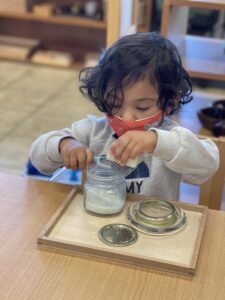 10:25 am to 10:38 am – Tori’s patience had paid off; the Soap Grating activity was on the shelf. Tori grated the bar of soap. This is fantastic work to develop the muscles in the hand to hold a pencil. Not to mention, developing her concentration and coordination.
10:25 am to 10:38 am – Tori’s patience had paid off; the Soap Grating activity was on the shelf. Tori grated the bar of soap. This is fantastic work to develop the muscles in the hand to hold a pencil. Not to mention, developing her concentration and coordination.
I found myself wanting to grate the soap. It is an extremely attractive activity.
10:40 am – Tori took out the clothes pinning activity and sat at the same table she grated the soap.
10:42 am – Tori is moving around classroom, dancing, and singing to herself
10:43 am – Tori sat at a work rug with another friend and asked the friend “can I work with you?”. The friend, who had the Trinomial Cube out, said no. It took Tori a few moments to accept this answer.
The guide noticed that Tori had some grated soap on her forehead. Not wanting Tori to get soap in her eyes, the guide took her to the bathroom and helped her wash the soap from her forehead.
10:53 am – Tori started to cry; I think she did get some soap in her eyes. After a moment, the guide asked her if she would like a tissue and a drink of water. Tori agreed, and followed the guide to the tissue box, took a tissue and wiped her face, then got a drink of water, threw cup in trash.
10:57 am – Tori took out the sponge squeezing with a garlic press activity. She sat at a table with this work.
11:00 am – Tori joined the rug area where the older children were working with the guide. They had math and language – word building and addition out. Tori chose the Trinomial Cube. This activity is an upper piece of material. Tori waited and the guide began the lesson with her. Tori stayed with this work until clean up time.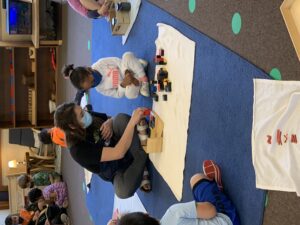
11:10 am – The work period would wrap up at 11:15 am, I was speaking with the guide for a few minutes.
11:15 am came and we both noticed that there were 7 to 8 children on the line, they were beginning the “walk the line” activity. The guide had smooth jazz playing softly in the background. Typically, the change from the “work period” music to the” walk the line” music would cue the children to put away their work and join the line. However, because of the consistency, the fostering of independence and the confidence of these children, they know exactly when to transition, they just naturally began the transition from work to the line. For the adults in the classroom, this was a magical moment.
11:15 am – Tori restored the Trinomial Cube and rolled her rug. She joined the older friends on the line.
I have used Tori, a 3-year-old child new to the environment, new to the school. It is mid-September and our school year just started.
The prepared Montessori classroom environment is designed to allow children to very easily engage with the classroom materials and start on the road to independence. This is a very typical day for a 3-year-old in our classroom community. Tori had 2.5 hours of freedom of movement, to be herself, to take care of her needs. Can you see how the child’s work is their play?
In upcoming blogs, please stay tuned as I will also follow a 4-year-old and also a Kindergarten age child through the morning work period. Hopefully, this gives you a bit of a glance into our day.
Montessori and Imaginative Play: Clearing the Confusion
Montessori View on Pretend Play
The Montessori Work Cycle Continued